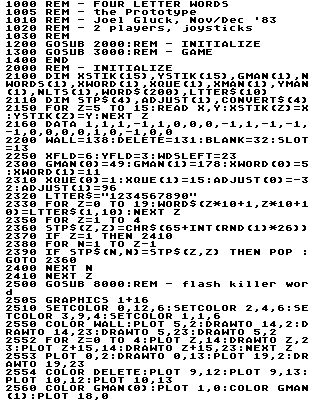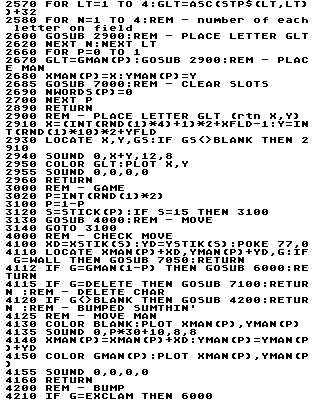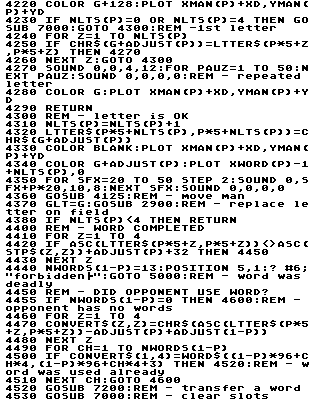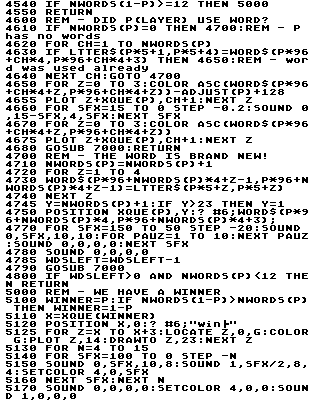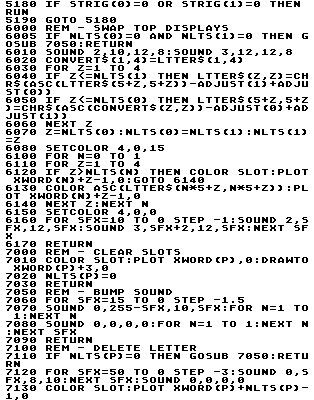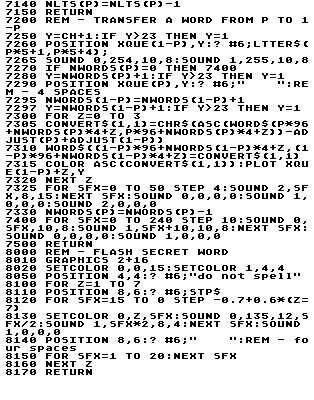This is no ordinary Our Game, no siree! This is a special edition. What makes it special? Well, for one thing, there'll be none of the usual features - no viewer mail, no tutorials. Instead, there's a big, ugly program listing and a whole bunch of excuses and explanations.
Excuses and explanations.
Listing 1 is a prototype of a game - sort of. I wrote it in order to give you, the reader, a good idea of what a prototype looks like, and to introduce you to the style of programming that our game (the game we are going to be writing together in the coming months) is going to be written in.
In some ways, I have failed to achieve my purpose. The program is rather large (almost 9.5K) - something a prototype shouldn't be. This is because I succumbed to the temptation to include features that should only appear in a final version. I had good reason for doing this; why should you have to spend valuable time typing in what is merely an unexciting prototype and not a full-fledged game?
This pseudo-prototype game is called Four Letter Words (or FLW). The object is to spell a dozen unique combinations of the given four letters before your opponent can do the same. Most of the combinations are nonsense words, which count nonetheless. You spell words by moving your "man" (represented by either a "1" or a "2") and bumping into the desired letter on the playfield. Repeating letters in a word is not permitted.
The above describes what would have been a very nice prototype. But noooo! I just wasn't satisfied.
- Superfluous Feature 1: There is a special box in the middle of the playing field. By bumping into it, you can delete the last letter of the word you are currently building.
- Superfluous Feature 2: If you attempt to spell a word that is already on your opponent's list, as a penalty the last word on your list is transferred to your opponent's list. (Note: If you try to repeat a word already on your own list, you are buzzed at but nothing happens.)
- Superfluous Feature 3: There is a "Forbidden Word" which is announced at the beginning of each game. If you spell the word, you lose the game. Simple enough?
- Superfluous Feature 4: If you bump into your opponent's man, the two word-building displays switch. This means that whatever word you were working on, your opponent is now working on, and vice versa.
- Superfluous Feature 5: There are plenty of elementary graphics and sound effects thrown in, just to liven things up.
That, in a nutshell, is the game. It may not sound like much fun. I have found that to be true of many games - a description of the game can sound very dry (especially in today's world of television, advertising and hype). However, I assure you that FLW is good. I've had about ten people playtest the game, and all but one like it. As a matter of fact, many of the features mentioned above stern from comments I elicited from playtesters.
Best of all, the game tries to achieve some of the game writing goals we've talked about in Our Game. For example, FLW is nonviolent, equally appealing to both sexes (and, to be hoped, a variety of age groups), and is a simultaneous two-player game.
So what's missing?
If FLW is so great, what's missing? Well, for one thing, the graphics are less than spectacular. I used character graphics (mode one), and did not modify the character set to improve the game's appearance. Also, the game is not complete. It is missing a title sequence, instructions, options, and a proper ending. As a matter of fact, when the game ends, it just sits and waits until either player pushes his/her trigger and then starts over. To exit the game you have to hit BREAK, SYSTEM RESET or the power switch.
These deficiencies are not really deficiencies at all; they are common features of typical prototypes. The whole point of a prototype is to bring the basic idea of a game to life, not to create a finished product.
Big and ugly.
The listing itself, as I said before, is big and ugly. To be exact, it is 205 logical lines long. And, since many of these lines take up more than one physical line, the resulting length is about 13 Atari-screen fulls.
The ugliness of the listing can be attributed to a few things. For one, it has not been renumbered. This is for a reason; I frequently use line numbers to set off different parts of the program. This helps during programming and debugging; if I need to see a part of the program, I usually know the appropriate location of that part by line number. The strange numbering also helps reinforce the idea that the program is somewhat structured; it is divided into independent procedures.
The program is also ugly in that there are few REMarks, and most of those are not very understandable. This will not happen when we write our game. (Note: when typing in the listing, leave in all REMs that appear alone on a line. Frequently, these lines are referenced by GOSUBs or GOTOS.)
There is other, random ugliness. Many lines are long, and some are almost maximum length. This is not a good thing. Also, there are many complex string statements that look like pure nonsense. I would have avoided them if I could, but I couldn't, so I didn't.
The final insult.
Well, there you are. I present you with a big, ugly program to type in to your computer, with only the slightest guarantee that it will be worthwhile.
Gee, the least I could do would be to explain how the program works!
Sorry, not a chance. It's not worth my while because it wouldn't do you any good. I've found that one does not learn much from typing in a program, even if there are accompanying explanations. If you'd like to learn from the experience, get a good book on Atari BASIC and figure out for yourself how what happens on the screen coincides with what's going on in the program. If you're more advanced than that, try dissecting some of the more complex string statements in the program.
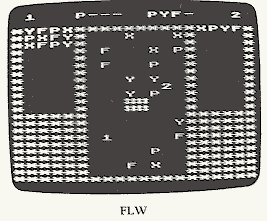
However, the best way to learn programming is to write you own programs, from scratch, often. Set problems or puzzles for yourself and solve them on your computer. Spend time experimenting with graphics, sound, and forms of input like the keyboard and the joysticks. Try new things, take on new challenges. The more you do your own programming, the better a programmer you will be.
Some things never change.
No, Our Game wouldn't be quite the same without the traditional "call for mail."
If you liked FLW and have ideas that could go into a final version of it, or if you didn't like it and have suggestions for improvement, or if you just have a better name for the game than FLW, send us mail!
If you have any ideas for Our Game, send us mail! If you have any ideas about the state of computer/video games in general, send us mail!
The address is:
c/o ANALOG Magazine
P.O. Box 23
Worcester, MA 01603
Next month, it's back to the regular format. Don't miss the next Our Game!
1000 DATA 16,103,109,491,278,148,205,2
65,897,761,760,718,798,328,964,6841
2300 DATA 151,701,900,306,186,600,564,
732,954,513,550,29,357,295,251,7089
2552 DATA 439,29,421,498,362,753,895,8
48,166,729,324,328,412,528,814,7546
2900 DATA 164,910,191,721,170,242,814,
966,398,508,236,257,714,760,886,7937
4110 DATA 213,589,696,0,715,167,913,70
5,250,222,794,20,151,771,872,7078
4240 DATA 80,188,829,648,242,800,641,2
02,989,950,310,317,375,116,50,6737
4400 DATA 602,189,610,556,934,636,879,
194,840,561,814,654,125,892,954,9440
4540 DATA 90,805,399,14,391,926,134,43
3,420,850,413,422,991,260,546,7094
4720 DATA 199,202,566,454,201,549,233,
421,962,67,526,332,929,649,328,6618
5130 DATA 362,648,106,813,633,336,745,
954,95,273,760,183,707,883,551,8049
6070 DATA 465,505,149,184,308,92,558,6
54,939,799,101,31,843,794,889,7311
7060 DATA 814,938,938,800,286,228,579,
459,207,799,335,748,232,407,537,8307
7280 DATA 439,53,972,992,187,221,967,1
60,558,756,546,82,806,925,346,8010
8020 DATA 423,631,196,521,20,598,225,8
71,558,803,4846